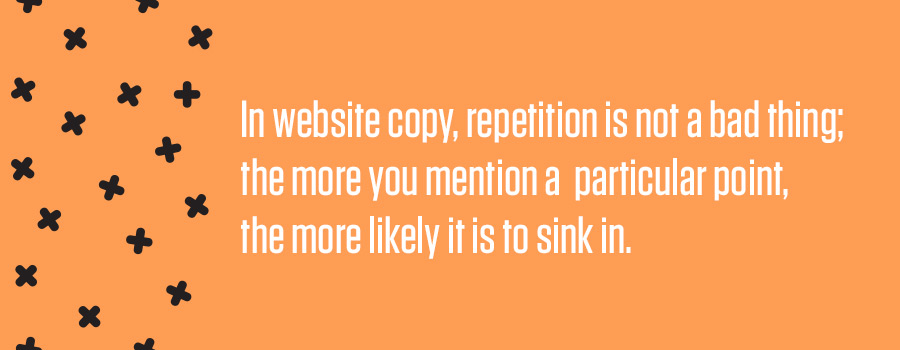
How To Write Website Copy That Sells
To write website copy that sells, you have to think like a salesperson. Your first step is to clearly differentiate the various types of sales resistance your copy must overcome. There are basically three types of sales resistance:
1. Skepticism. When prospects are skeptical, they want what you’re selling, but they are not sure about your company’s ability to supply it.
2. Objections. When prospects have objections, they want what you’re selling, have some degree of confidence in your company’s ability to supply it, but have a specific issue(s) holding them back from inquiring or buying.
3. Indifference. When prospects are indifferent, they don’t want what you’re selling, either because they don’t recognize a need for it, or feel their need is already being met by one of your competitors.
Before writing a word of website copy, create a list of talking points that address each of these areas of resistance. This is quite a bit more complicated than you might imagine, as there are different types of resistance within each category. Let’s take a look.

Overcoming Skepticism
Skeptical website visitors might be skeptical about your company, your product/service, or you. The talking points you need to have at the ready should cover points such as these:
- Skeptical of your company
- Years in business
- Awards
- Certifications
- Revenue
- Market share
- Number of employees
- Testimonials
- Skeptical of your products/service
- Positive user reviews
- Fill rates
- Product design patents
- Product quality data
- Unexaggerated product/claims
- Unexaggerated benefit claims
- Testimonials
- Skeptical of you
- Bios highlighting accomplishments
- Bios of leadership and staff
- Descriptions of company culture
- Data confidentiality statements on contact forms
- Customer-appropriate writing style
- Concise, clear, error-free, customer-focused composition
The challenge, and where you need input from the sales team, is isolating the truly important talking points. For instance, fill rates may be hugely important, but product patents not important at all — how is a copywriter to know? Copy written in a vacuum will never ring true.
Overcoming Objections
Objections come in several flavors:
- Real objections are legitimate roadblocks to making a sale. For instance, a prospect may feel your product does not have a particular essential attribute — and that attribute is indeed missing. The talking points you’ll need here must minimize the importance of that particular drawback, or demonstrate a way to compensate for it (such as offering an extended warranty or extra discount).
- Perceived objections are ones where the prospect thinks there’s a problem, but there really isn’t. For perceived objections, talking points must be fact-heavy; perceived objections are caused by a prospect’s lack of information, or being misinformed.
- Company-related objections revolve around issues such as your company being too new, too set in its ways, too small, too big, etc. Thus, talking points here are ones that showcase the experience of a new company, the innovation of an old-line company, the breadth of service of a small company and the personalized approach of a big company.
- Product/service-related objections must be hashed out one at a time with help from the sales team. The real key for copywriters is to develop talking points that provide enough information to address the point and prompt an inquiry, rather than provide too much detail in an attempt to replace the sales team altogether.
- Relationship objections are difficult to deal with. If a prospect has a great relationship with its existing supplier, you cannot overcome it with website copy. If a prospect has a negative perception of your company based on past experience or reputation (e.g., poor follow-through, lack of transparency), website copy alone cannot fix the problem. What a copywriter can do is create talking points that emphasize fresh starts, second looks, new business approaches, and new team members with stellar track records. Properly placed in the web copy, these talking points may be just enough to prompt an inquiry.
Overcoming Indifference
As they say, the opposite of love is not hate, but indifference. This fact of life sure makes life difficult for a copywriter!
One way copywriters try to overcome indifference is by using a lot of “flair” — exaggerated benefit statements, flowery adjectives, multiple exclamation points, bold text, etc. For the most part, these ham-fisted techniques backfire, by making indifferent prospects skeptical as well. Better approaches to overcoming indifference:
- Add meaningful detail to benefit statements. Saying “this product will increase your throughput 10 percent” may be more than enough for an interested prospect, but an indifferent one will need you to spell out in dollars and cents what a 10-percent increase means to the bottom line.
- Talk about the personal benefits of the business benefits. A key to overcoming indifference is getting personal. Explaining in detail how a 10-percent throughput increase improves the bottom line is great, but even greater is to paint your website visitor a picture of how that improvement may lead to a promotion. Even in the driest of dry industries, people are people — and motivated by personal gain and emotional appeals.
- Create fear. Speaking of emotion, fear is the greatest motivator — if the copywriter knows how to channel it. What are prospects afraid of? Typically, it will be things such as letting competitors get an edge, missing out on a new market opportunity, letting profits leak out the door or paying too much in taxes. So, a case study showing how one of your clients saved 40 percent or grabbed 5 percent of a new market with your service will arouse fear in a competitor who visits your website.
Deploying Your Talking Points
When the dust settles on this laundry list of talking points, it’s likely to be rather large. Spewing them indiscriminately on every page of the website clearly won’t do, so you must use common sense to weave the talking points into the copy in the right place at the right time. Tips:
- Distinguish universally important talking points from specific ones. For instance, mentioning “Over 10,000 satisfied customers” may be worth stating on every page; whereas mentioning “Product A is 12 percent lighter weight than the competitive brands” may be worth stating on the Product A site page only.
- Lead with strength. For any given web page, what is the most important selling point? This is your lead. Again, I can’t overemphasize the value in getting input from the sales team. One thing we try to do on our website projects is get the top 2-5 talking points for each page from the client. We can make educated guesses — often very good ones — but the client knows.
- Place strong selling points above and below calls to action. A lead generation website is after conversions: phone inquiries and form submissions. So, the point(s) on the web page where you ask visitors to call or fill out a contact form is where you want to insert a tautly worded selling point sure to get the prospect thinking.
- More of less is better than less of more. Just because you have a long list of talking points doesn’t mean you should use all of them, or all of them equally. In website copy, repetition is not a bad thing; the more you mention a particular point, the more likely it is to sink in. So, if you’ve accumulated 50 customer testimonials in your preparation, it’s OK if you decide to use, say, the 10 most compelling throughout the site, and not bother with the other 40.
- Test. This goes beyond the scope of pure copywriting, but if your company/client is smart, it will test various talking points in an effort to improve conversions. Who knows? One or two of those 40 case studies you didn’t use may turn out to be the real winners. The only way to know for sure is to try them on a live audience.
Creating website copy that sells requires interaction with the sales team and a fair amount of preparation. However, the interaction greatly increases the conversion quality of your content, and the preparation makes the actual writing go quickly, with far less mental agony. Give it a try!




